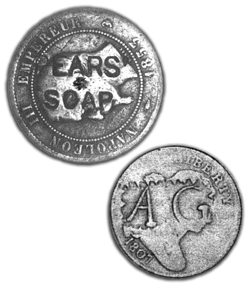|
"Making Cents"
The Signal
Saturday, July 22, 2006
| F |
"Coins were counterstamped or countermarked for three basic purposes: (1) To indicate official sanction or adoption as legal specie (mostly in the West Indies and South America); (2) for advertising, symbolic or utilitarian purposes for merchants, fraternal organizations, political campaigns, admission requirements, etc.; (3) for ... testing purposes such as silversmiths testing their punches."
Today, hundreds of different counterstamped coins are listed in Russell Rulau's "Standard Catalog of United States Tokens." A few examples include pieces that are well known in numismatic circles such as Sages Candy Coin; Dr. G.G. Wilkins; J.J. Polhemus, Druggist (Sacramento); China Tea Co.; Try Corey's Ointment; J.J. Outley, Artist; and many, many more.
Gould's first article on the subject in 1947 focused only on counterstamped large cents (1793-1857). Many of these counterstamps appear on more than one type of coin, and in some cases on foreign coins, as well.
One of the more intriguing counterstamps was by the British soap company known as Pears. Around 1810, the company decided to advertise its product — a mild, clear bar of soap that had only limited distribution.
Advertising was not considered as a means of promoting products in those days, so the idea was radical. Further, there was a law in Great Britain prohibiting the defacing the monarch's portrait, so the use of British coins for advertising was not permissible. The company president ordered about a quarter million copper coins from France, which in the late 1800s were the same size as a British penny and were generally accepted as pennies in Britain. These French 10-centime pieces were counterstamped in large, bold letters, "Pears Soap," with a small star in the center.
These pieces circulated widely for a few years before the Parliament decided that such pieces were unlawful and ordered them confiscated and destroyed. Fortunately, enough escaped destruction and are widely accepted and traded among collectors today. Gould owned quite a few.
When Gould died in 1975, I acquired much of his estate to sell on behalf of his widow, including hundreds of counterstamped coins, almost all of which are listed in Rulau's book. The collection was sold in two mail-bid sales in 1976 and 1977.
The practice of using counterstamped coins for advertising faded away by the late 1800s as more convenient means of advertising came on the scene such as tokens in various metals, plastics and even cardboard; elongated (stretched) coins, starting in 1892 at the Columbian World's Fair; and encased coins (possibly starting in 1904 at the St. Louis World's Fair).
The use of tokens for advertising existed along with counterstamped coins but expanded greatly at the end of the 1800s and grew steadily in the 1900s. Today, many of these older advertising pieces bring record prices when offered at auction.
In the S.S. Central America gold treasure found a few years ago, one $20 piece was found with the J.J. Polhemus counterstamp. It is valued in the five-figure range. Today many of the Gould pieces command well into the four figures as their popularity grows among serious collectors.
Dr. Sol Taylor of Sherman Oaks is president of the Society of Lincoln Cent Collectors and author of The Standard Guide to the Lincoln Cent. Click here for ordering information.
©2006, THE SIGNAL · ALL RIGHTS RESERVED.

![[Most Recent Quotes from www.kitco.com]](http://www.kitconet.com/images/quotes_special.gif)

